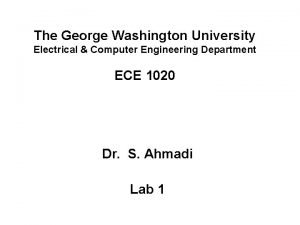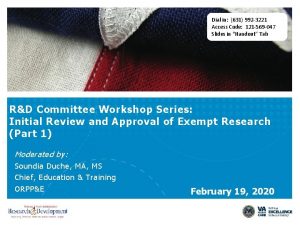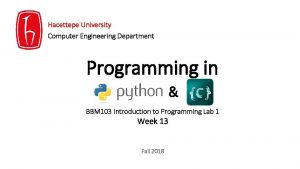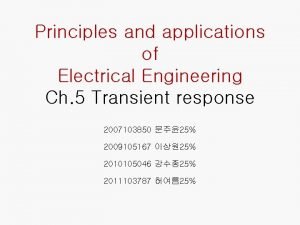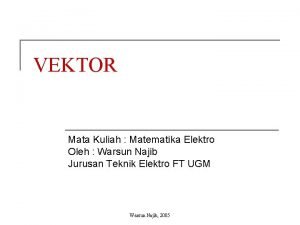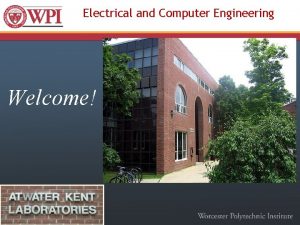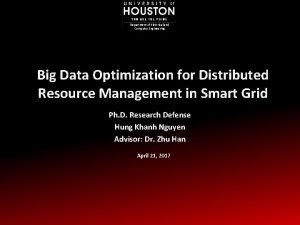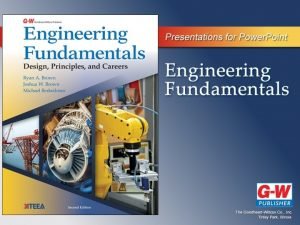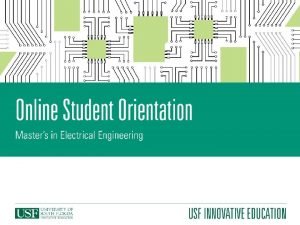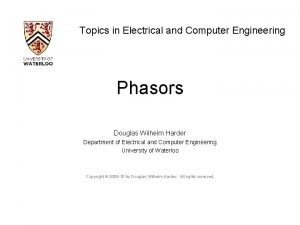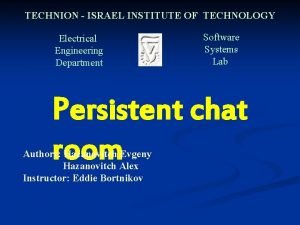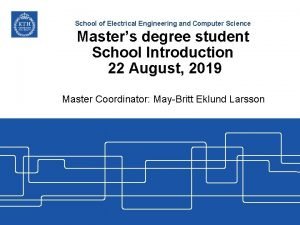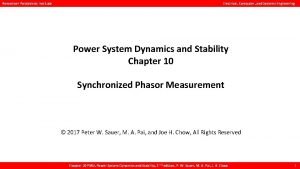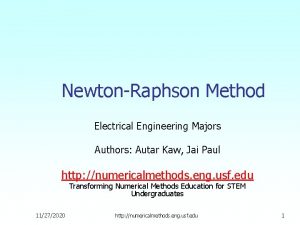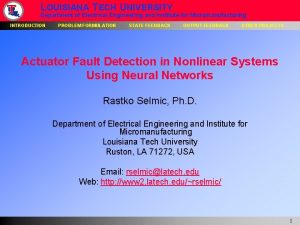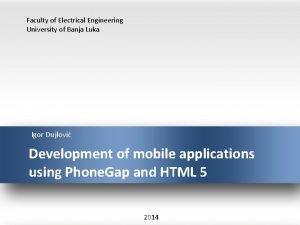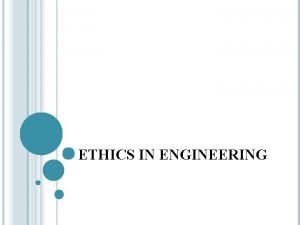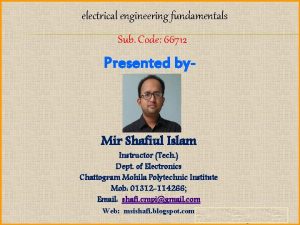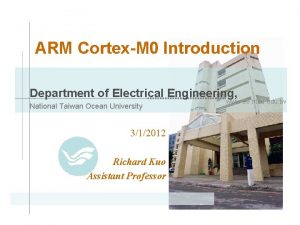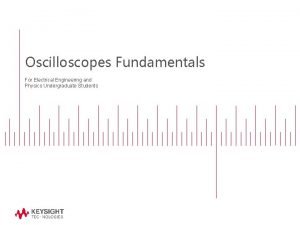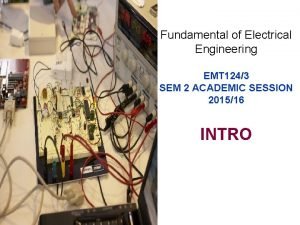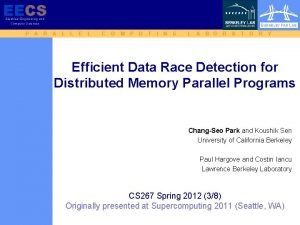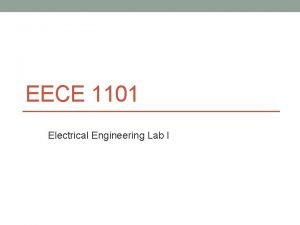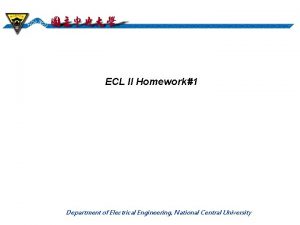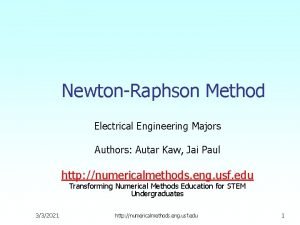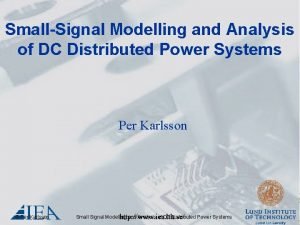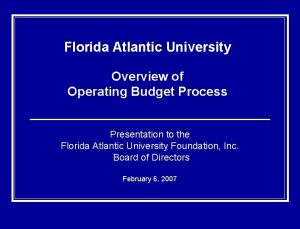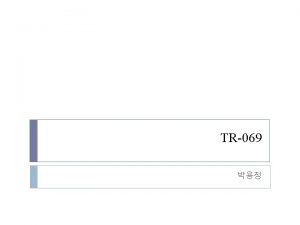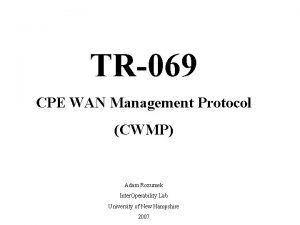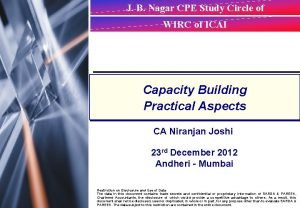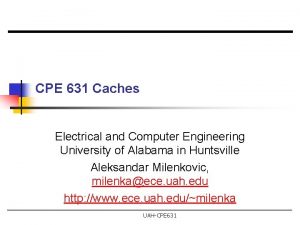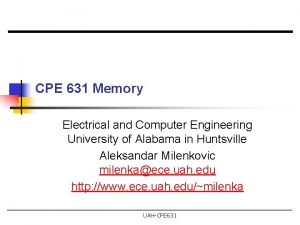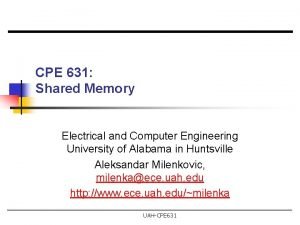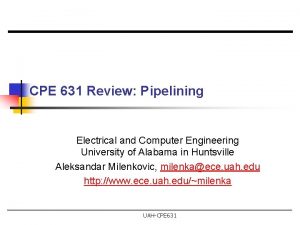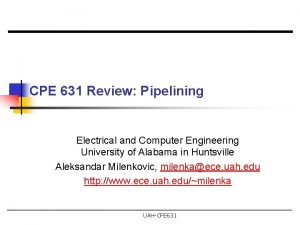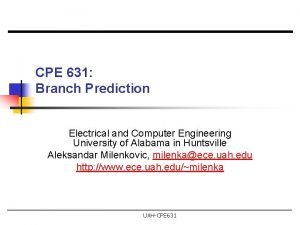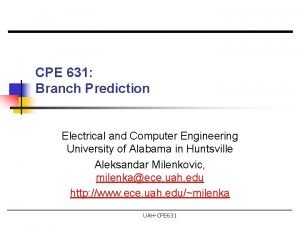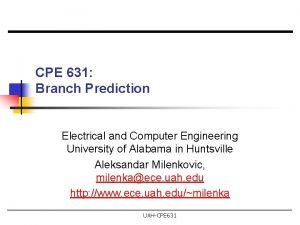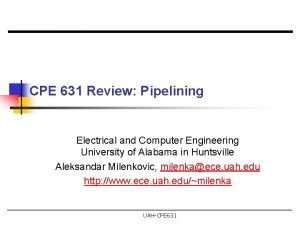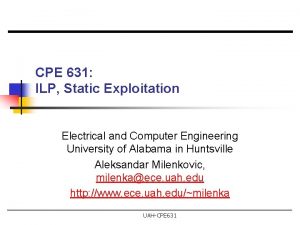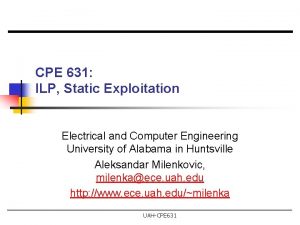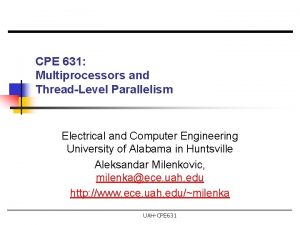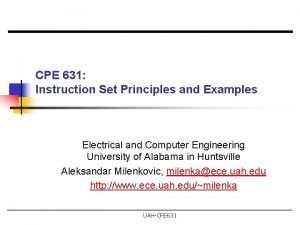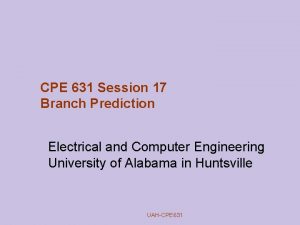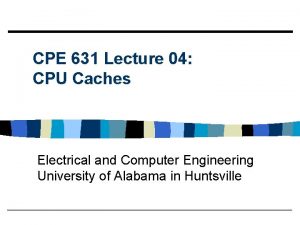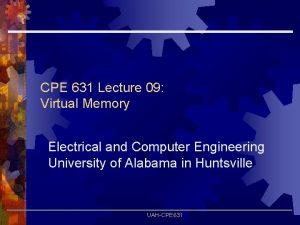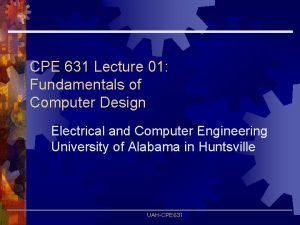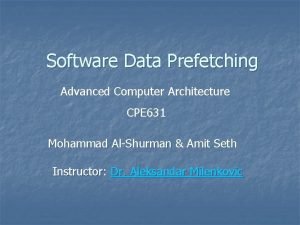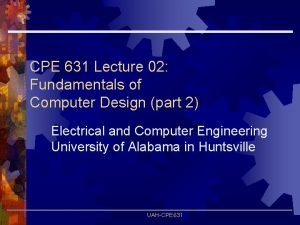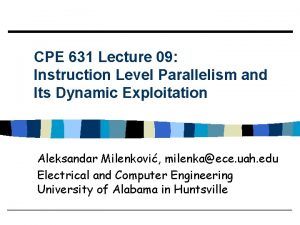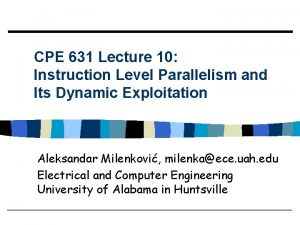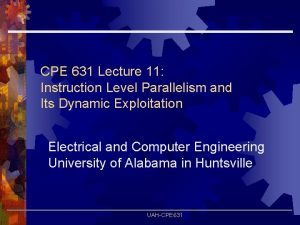CPE 631 Introduction Electrical and Computer Engineering University














![Instruction Set Architecture “. . . the attributes of a [computing] system as seen Instruction Set Architecture “. . . the attributes of a [computing] system as seen](https://slidetodoc.com/presentation_image_h/fac4c8ef919e946795cf31a07d866a68/image-15.jpg)




























![An Example n Plane DC to Paris [hour] Top Speed [mph] Passe -ngers Throughput An Example n Plane DC to Paris [hour] Top Speed [mph] Passe -ngers Throughput](https://slidetodoc.com/presentation_image_h/fac4c8ef919e946795cf31a07d866a68/image-44.jpg)
![Definition of Performance n We are primarily concerned with Response Time Performance [things/sec] n Definition of Performance n We are primarily concerned with Response Time Performance [things/sec] n](https://slidetodoc.com/presentation_image_h/fac4c8ef919e946795cf31a07d866a68/image-45.jpg)


























- Slides: 71

CPE 631: Introduction Electrical and Computer Engineering University of Alabama in Huntsville Aleksandar Milenkovic milenka@ece. uah. edu http: //www. ece. uah. edu/~milenka UAH-CPE 631

Lecture Outline n n n Evolution of Computer Technology Computing Classes Task of Computer Designer Technology Trends Costs and Trends in Cost Things to Remember AM La. CASA 2

Introduction CHANGE! It is exciting. It has never been more exciting! It impacts every aspect of human life. Eniac, 1946 Play. Station Portable (PSP) Approx. 170 mm (L) x 74 mm (W) x 23 mm (D) Weight: Approx. 260 g (including battery) (first stored-program computer) CPU: PSP CPU (clock frequency 1~333 MHz) Occupied 50 x 30 feet room, Main Memory: 32 MB weighted 30 tonnes, Embedded DRAM: 4 MB AM contained 18000 electronic valves, consumed 25 KW of electrical power; Profile: PSP Game, UMD Audio, UMD Video capable to perform 100 K calc. per second La. CASA 3

A short history of computing n n Continuous growth in performance due to advances in technology and innovations in computer design First 25 years (1945 – 1970) n n Late 70 s, emergence of the microprocessor n n La. CASA n 35% yearly growth in performance thanks to integrated circuit technology Changes in computer marketplace: elimination of assembly language programming, emergence of Unix easier to develop new architectures Mid 80 s, emergence of RISCs (Reduced Instruction Set Computers) n AM 25% yearly growth in performance Both forces contributed to performance improvement Mainframes and minicomputers dominated the industry 52% yearly growth in performance Performance improvements through instruction level parallelism (pipelining, multiple instruction issue), caches Since ‘ 02, end of 16 years of renaissance n n n 20% yearly growth in performance Limited by 3 hurdles: maximum power dissipation, instruction-level parallelism, and so called “memory wall” Switch from ILP to TLP and DLP (Thread-, Data-level Parallelism) 4

Growth in processor performance From Hennessy and Patterson, Computer Architecture: A Quantitative Approach, 4 th edition, October, 2006 AM La. CASA • VAX : 25%/year 1978 to 1986 • RISC + x 86: 52%/year 1986 to 2002 • RISC + x 86: 20%/year 2002 to present 5

Effect of this Dramatic Growth n Significant enhancement of the capability available to computer user n n Microprocessor-based computers dominate n n AM La. CASA Example: a today’s $500 PC has more performance, more main memory, and more disk storage than a $1 million computer in 1985 n n Workstations and PCs have emerged as major products Minicomputers - replaced by servers Mainframes - replaced by multiprocessors Supercomputers - replaced by large arrays of microprocessors 6

Changing Face of Computing n In the 1960 s mainframes roamed the planet n n n In the 1970 s, minicomputers emerged n n n AM La. CASA Very expensive, operators oversaw operations Applications: business data processing, large scale scientific computing Less expensive, time sharing In the 1990 s, Internet and WWW, handheld devices (PDA), high-performance consumer electronics for video games and set-top boxes have emerged Dramatic changes have led to 3 different computing markets n Desktop computing, Servers, Embedded Computers 7

Computing Classes: A Summary Feature Desktop Server Embedded Price of the system $500 -$5 K $5 K-$5 M $10 -$100 K (including network routers at high end) Price of the processor $50 -$500 $200 -$10 K $0. 01 - $100 Sold per year (estimates for 2000) 150 M 4 M 300 M (only 32 -bit and 64 -bit) Critical system design issues Price-performance, Throughput, graphics availability, performance scalability Price, power consumption, application-specific performance AM La. CASA 8

Desktop Computers n n n Largest market in dollar terms Spans low-end (<$500) to high-end ( $5 K) systems Optimize price-performance n n AM La. CASA n n Performance measured in the number of calculations and graphic operations Price is what matters to customers Arena where the newest, highest-performance and cost-reduced microprocessors appear Reasonably well characterized in terms of applications and benchmarking What will a PC of 2011 do? What will a PC of 2016 do? 9

Servers n n Provide more reliable file and computing services (Web servers) Key requirements n n n AM La. CASA n n Availability – effectively provide service 24/7/365 (Yahoo!, Google, e. Bay) Reliability – never fails Scalability – server systems grow over time, so the ability to scale up the computing capacity is crucial Performance – transactions per minute Related category: clusters / supercomputers 10

Embedded Computers n n AM La. CASA n Fastest growing portion of the market Computers as parts of other devices where their presence is not obviously visible n E. g. , home appliances, printers, smart cards, cell phones, palmtops, set-top boxes, gaming consoles, network routers Wide range of processing power and cost n $0. 1 (8 -bit, 16 -bit processors), $10 (32 -bit capable to execute 50 M instructions per second), $100 -$200 (high-end video gaming consoles and network switches) Requirements n Real-time performance requirement (e. g. , time to process a video frame is limited) n Minimize memory requirements, power SOCs (System-on-a-chip) combine processor cores and application-specific circuitry, DSP processors, network processors, . . . 11

Task of Computer Designer n n “Determine what attributes are important for a new machine; then design a machine to maximize performance while staying within cost, power, and availability constraints. ” Aspects of this task n n n AM La. CASA Instruction set design Functional organization Logic design and implementation (IC design, packaging, power, cooling. . . ) 12

What is Computer Architecture? Computer Architecture covers all three aspects of computer design n Instruction Set Architecture n n Organization n AM La. CASA n the computer visible to the assembler language programmer or compiler writer (registers, data types, instruction set, instruction formats, addressing modes) high level aspects of computer’s design such as the memory system, the bus structure, and the internal CPU (datapath + control) design Hardware n detailed logic design, interconnection and packing technology, external connections 13

Instruction Set Architecture: Critical Interface software instruction set hardware n Properties of a good abstraction n AM La. CASA n n n Lasts through many generations (portability) Used in many different ways (generality) Provides convenient functionality to higher levels Permits an efficient implementation at lower levels 14
![Instruction Set Architecture the attributes of a computing system as seen Instruction Set Architecture “. . . the attributes of a [computing] system as seen](https://slidetodoc.com/presentation_image_h/fac4c8ef919e946795cf31a07d866a68/image-15.jpg)
Instruction Set Architecture “. . . the attributes of a [computing] system as seen by the programmer, i. e. the conceptual structure and functional behavior, as distinct from the organization of the data flows and controls the logic design, and the physical implementation. ” Amdahl, Blaauw, and Brooks, 1964 SOFTWARE • Organization of Programmable Storage (GPRs, SPRs) • Data Types & Data Structures: Encodings & Representations • Instruction Formats AM La. CASA • Instruction (or Operation Code) Set • Modes of Addressing and Accessing Data Items and Instructions • Exceptional Conditions 15

Example: MIPS 64 n Registers n n n Data types n n n La. CASA 8 -bit bytes, 16 -bit half-words, 32 -bit words, 64 -bit double words for integer data 32 -bit single- or 64 -bit double-precision numbers Addressing Modes for MIPS Data Transfers n AM 32 64 -bit general-purpose (integer) registers (R 0 -R 31) 32 64 -bit floating-point registers (F 0 -F 31) n n Load-store architecture: Immediate, Displacement Memory is byte addressable with a 64 -bit address Mode bit to select Big Endian or Little Endian 16

Example: MIPS 64 n MIPS Instruction Formats (R-type, I-type, J-type) Register-Register 31 Op 26 25 2120 16 15 Rs 1 Rs 2 Rd Register-Immediate 31 26 25 2120 16 15 Op Rs 1 Rd Branch 31 Op AM La. CASA 26 25 2120 16 15 Rs 1 Rs 2/Opx 1110 65 0 Opx immediate 0 0 Jump / Call 31 26 25 Op target 0 17

Example: MIPS 64 n MIPS Operations (See Appendix B, Figure B. 26) n n n AM La. CASA n Data Transfers (LB, LBU, SB, LHU, SH, LWU, SW, LD, SD, L. S, L. D, S. S, S. D, MFCO, MTCO, MOV. S, MOV. D, MFC 1, MTC 1) Arithmetic/Logical (DADD, DADDI, DADDU, DADDIU, DSUBU, DMULU, DDIVU, MADD, ANDI, ORI, XORI, LUI, DSLL, DSRA, DSLLV, DSRAV, SLTI, SLTU, SLTIU) Control (BEQZ, BNEZ, BEQ, BNE, BC 1 T, BC 1 F, MOVN, MOVZ, J, JR, JALR, TRAP, ERET) Floating Point (ADD. D, ADD. S, ADD. PS, SUB. D, SUB. S, SUB. PS, MUL. D, MUL. S, MUL. PS, MADD. D, MADD. S, MADD. PS, DIV. D, DIV. S, DIV. PS, CVT. _. _, C. _. D, C. _. S 18

Computer Architecture is Design and Analysis Architecture is an iterative process: • Searching the space of possible designs • At all levels of computer systems Creativity Cost / Performance Analysis Good Ideas AM La. CASA Bad Ideas Mediocre Ideas 19

Computer Engineering Methodology Market Implementation Complexity Evaluate Existing Systems for Bottlenecks Applications Benchmarks Technology Trends Implement Next Generation System Simulate New Designs and Organizations AM La. CASA Workloads 20

Technology Trends n Integrated circuit technology – 55% /year n n n Semiconductor DRAM n n n AM La. CASA Density – 40 -60% per year (4 x in 3 -4 years) Cycle time – 33% in 10 years Bandwidth – 66% in 10 years Magnetic disk technology n n Transistor density – 35% per year Die size – 10 -20% per year Density – 100% per year Access time – 33% in 10 years Network technology (depends on switches and transmission technology) n n 10 Mb-100 Mb (10 years), 100 Mb-1 Gb (5 years) Bandwidth – doubles every year (for USA) 21

Processor Transistor Count Intel Mc. Kinley – 221 M tr. (2001) Intel 4004, 2300 tr (1971) AM La. CASA Intel P 4 – 55 M tr (2001) Intel Core 2 Extreme Quad -core 2 x 291 M tr. (2006) 22

Processor Transistor Count (from http: //en. wikipedia. org/wiki/Transistor_count) Processor AM La. CASA Transistor count Date of introduction Manufactu -rer Processor Transistor count Date of introduction Manufacturer Intel 4004 2300 1971 Intel Itanium 25 000 2001 Intel 8008 2500 1972 Intel Barton 54 300 000 2003 AMD Intel 8080 4500 1974 Intel AMD K 8 105 900 000 2003 AMD Intel 8088 29 000 1978 Intel Itanium 2 220 000 2003 Intel 80286 134 000 1982 Intel 592 000 2004 Intel 80386 275 000 1985 Intel Itanium 2 with 9 MB cache Intel 80486 1 200 000 1989 Intel Cell 241 000 2006 Pentium 3 100 000 1993 Intel Sony/IBM/ Toshiba AMD K 5 4 300 000 1996 AMD Core 2 Duo 291 000 2006 Intel Pentium II 7 500 000 1997 Intel Core 2 Quadro 582 000 2006 Intel AMD K 6 8 800 000 1997 AMD 1 700 000 2006 Intel Pentium III 9 500 000 1999 Intel AMD K 6 -III 21 300 000 1999 AMD K 7 22 000 1999 AMD Pentium 4 42 000 2000 Intel Dual-Core Itanium 2 23

Technology Directions: SIA Roadmap (from 1999) AM La. CASA 24

Technology Directions (ITRS – Int. Tech. Roadmap for Semicon. , 2006 ed. ) n n ITRS yearly updates In year 2017 (10 years from now) n n n Gate length (high-performance MPUs): 13 nm (printed), 8 nm (physical) Functions per chip at production (in million of transistors): 3, 092 For more info check the $HOME/docs/00_Exec. Sum 2006 Update. pdf AM La. CASA 25

Cost, Price, and Their Trends n n n Price – what you sell a good for Cost – what you spent to produce it Understanding cost n Learning curve principle – manufacturing costs decrease over time (even without major improvements in implementation technology) n n Volume (number of products manufactured) n n AM La. CASA n Best measured by change in yield – the percentage of manufactured devices that survives the testing procedure decreases the time needed to get down the learning curve decreases cost since it increases purchasing and manufacturing efficiency Commodities – products sold by multiple vendors in large volumes which are essentially identical n Competition among suppliers lower cost 26

Trends in Cost: The Price of DRAM and Intel Pentium III AM La. CASA 27

Trends in Cost: The Price of Pentium 4 and Pentium. M AM La. CASA 28

Integrated Circuits Variable Costs AM Example: Find the number of dies per 20 -cm wafer for a die that is 1. 5 cm on a side. Solution: Die area = 1. 5 x 1. 5 = 2. 25 cm 2. Dies per wafer = 3. 14 x(20/2)2/2. 25 – 3. 14 x 20/(2 x 2. 5)0. 5=110. La. CASA 29

Integrated Circuits Cost (cont’d) • What is the fraction of good dies on a wafer – die yield • Empirical model • defects are randomly distributed over the wafer • yield is inversely proportional to the complexity of the fabrication process AM La. CASA • Wafer yield accounts for wafers that are completely bad (no need to test them); We assume the wafer yield is 100% • Defects per unit area: typically 0. 4 – 0. 8 per cm 2 • corresponds to the number of masking levels; for today’s CMOS, a good estimate is =4. 0 30

Integrated Circuits Cost (cont’d) • Example: Find die yield for dies with 1 cm and 0. 7 cm on a side; defect density is 0. 6 per square centimeter • For larger die: (1+0. 6 x 1/4)-4=0. 57 • For smaller die: (1+0. 6 x 0. 49/4)-4=0. 75 • Die costs are proportional to the fourth power of the die area AM La. CASA • In practice 31

Real World Examples Chip AM La. CASA ML Line widt h Wafer cost Defect [cm 2] Area [mm 2] Dies/ wafer Yield Die cost 386 DX 2 0. 90 $900 1. 0 43 360 71% $4 486 DX 2 3 0. 80 $1200 1. 0 81 181 54% $12 Power. PC 601 4 0. 80 $1700 1. 3 121 115 28% $53 HP PA 7100 3 0. 80 $1300 1. 0 196 66 27% $73 Dec Alpha 3 0. 70 $1500 1. 2 234 53 19% $149 Super. SPARC 3 0. 70 $1700 1. 6 256 48 13% $272 Pentium 3 0. 70 $1500 1. 5 296 40 9% $417 From "Estimating IC Manufacturing Costs, ” by Linley Gwennap, Microprocessor Report, August 2, 1993, p. 15 Typical in 2002: 30 cm diameter wafer, 4 -6 metal layers, wafer cost $5 K-6 K 32

Trends in Power in ICs Power becomes a first class architectural design constraint n Power Issues n n n How to bring it in and distribute around the chip? (many pins just for power supply and ground, interconnection layers for distribution) How to remove the heat (dissipated power) Why worry about power? n n Battery life in portable and mobile platforms Power consumption in desktops, server farms n n AM La. CASA n Cooling costs, packaging costs, reliability, timing Power density: 30 W/cm 2 in Alpha 21364 (3 x of typical hot plate) Environment? n IT consumes 10% of energy in the US 33

Why worry about power? -- Power Dissipation Lead microprocessors power continues to increase Power (Watts) 100 P 6 Pentium ® 10 8086 286 1 8008 4004 486 386 8085 8080 0. 1 AM La. CASA 1971 1974 1978 1985 1992 2000 Year Power delivery and dissipation will be prohibitive Source: Borkar, De Intel 34

CMOS Power Equations Dynamic power consumption Power due to short-circuit current during transition Power due to leakage current Reduce the supply voltage, V AM La. CASA Reduce threshold Vt 35

Dependability: Some Definitions n n AM La. CASA n n Computer system dependability is the quality of delivered service The service delivered by a system is its observed actual behavior Each module has an ideal specified behavior, where a service specification is an agreed description of the expected behavior A failure occurs when the actual behavior deviated from the specified behavior The failure occurred because of an error The cause of an error is a fault 36

Dependability: Measures n n n AM n La. CASA Service accomplishment vs. service interruption (transitions: failures vs. restorations) Module reliability: a measure of the continuous service accomplishment A measure of reliability: MTTF – Mean Time To Failure (1/[rate of failure]) reported in [failure/1 billion hours of operation) MTTR – Mean time to repair (a measure for service interruption) MTBF – Mean time between failures (MTTF+MTTR) Module availability – a measure of the service accomplishment; = MTTF/(MTTF+MTTR) 37

Things to Remember n n n Computing classes: desktop, server, embedd. Technology trends La. CASA Speed Logic 4 x in 3+ years 2 x in 3 years DRAM 4 x in 3 -4 years 33% in 10 years Disk 4 x in 3 -4 years 33% in 10 years Cost n AM Capacity n n Learning curve: manufacturing costs decrease over time Volume: the number of chips manufactured Commodity 38

Things to Remember (cont’d) n Cost of an integrated circuit AM La. CASA 39

Design Space n n Performance Cost Power Dependability AM La. CASA 40

Measuring, Reporting, Summarizing Performance UAH-CPE 631

Cost-Performance n Purchasing perspective: from a collection of machines, choose one which has n n Computer designer perspective: faced with design options, select one which has n n n AM La. CASA n best performance? least cost? best performance/cost? best performance improvement? least cost? best performance/cost? Both require: basis for comparison and metric for evaluation 42

Two “notions” of performance n Which computer has better performance? n n n Users are interested in reducing Response time or Execution time n n AM La. CASA User: one which runs a program in less time Computer centre manager: one which completes more jobs in a given time the time between the start and the completion of an event Managers are interested in increasing Throughput or Bandwidth n total amount of work done in a given time 43
![An Example n Plane DC to Paris hour Top Speed mph Passe ngers Throughput An Example n Plane DC to Paris [hour] Top Speed [mph] Passe -ngers Throughput](https://slidetodoc.com/presentation_image_h/fac4c8ef919e946795cf31a07d866a68/image-44.jpg)
An Example n Plane DC to Paris [hour] Top Speed [mph] Passe -ngers Throughput [p/h] Boeing 747 6. 5 610 470 72 (=470/6. 5) Concorde 3 1350 132 44 (=132/3) Which has higher performance? n Time to deliver 1 passenger? n AM La. CASA n Concord is 6. 5/3 = 2. 2 times faster (120%) Time to deliver 400 passengers? n Boeing is 72/44 = 1. 6 times faster (60%) 44
![Definition of Performance n We are primarily concerned with Response Time Performance thingssec n Definition of Performance n We are primarily concerned with Response Time Performance [things/sec] n](https://slidetodoc.com/presentation_image_h/fac4c8ef919e946795cf31a07d866a68/image-45.jpg)
Definition of Performance n We are primarily concerned with Response Time Performance [things/sec] n “X is n times faster than Y” n n AM La. CASA As faster means both increased performance and decreased execution time, to reduce confusion will use “improve performance” or “improve execution time” 45

Execution Time and Its Components n Wall-clock time, response time, elapsed time n n CPU time n n n La. CASA the time the CPU is computing, excluding I/O or running other programs with multiprogramming often further divided into user and system CPU times User CPU time n AM n the latency to complete a task, including disk accesses, memory accesses, input/output activities, operating system overhead, . . . the CPU time spent in the program System CPU time n the CPU time spent in the operating system 46

UNIX time command n n n 90. 7 u 12. 9 s 2: 39 65% 90. 7 - seconds of user CPU time 12. 9 - seconds of system CPU time 2: 39 - elapsed time (159 seconds) 65% - percentage of elapsed time that is CPU time (90. 7 + 12. 9)/159 AM La. CASA 47

CPU Execution Time n n AM La. CASA Instruction count (IC) = Number of instructions executed Clock cycles per instruction (CPI) CPI - one way to compare two machines with same instruction set, since Instruction Count would be the same 48

CPU Execution Time (cont’d) IC AM La. CASA CPI Program X Compiler X (X) ISA X X Organisation Technology X Clock rate X X 49

How to Calculate 3 Components? n Clock Cycle Time n n Instruction count n n Count instructions in loop of small program Use simulator to count instructions Hardware counter in special register (Pentium II) CPI n AM La. CASA in specification of computer (Clock Rate in advertisements) n Calculate: Execution Time / Clock cycle time / Instruction Count Hardware counter in special register (Pentium II) 50

Another Way to Calculate CPI n n n First calculate CPI for each individual instruction (add, sub, and, etc. ): CPIi Next calculate frequency of each individual instr. : Freqi = ICi/IC Finally multiply these two for each instruction and add them up to get final CPI Op AM La. CASA Freqi CPIi Prod. % Time ALU 50% 1 0. 5 23% Load 20% 5 1. 0 45% Store 10% 3 0. 3 14% Bran. 20% 2 0. 4 18% 2. 2 51

Choosing Programs to Evaluate Per. n Ideally run typical programs with typical input before purchase, or before even build machine n n Workload – mixture of programs and OS commands that users run on a machine Few can do this n AM La. CASA Engineer uses compiler, spreadsheet Author uses word processor, drawing program, compression software n Don’t have access to machine to “benchmark” before purchase Don’t know workload in future 52

Benchmarks n Different types of benchmarks n n n AM La. CASA n Real programs (Ex. MSWord, Excel, Photoshop, . . . ) Kernels - small pieces from real programs (Linpack, . . . ) Toy Benchmarks - short, easy to type and run (Sieve of Erathosthenes, Quicksort, Puzzle, . . . ) Synthetic benchmarks - code that matches frequency of key instructions and operations to real programs (Whetstone, Dhrystone) Need industry standards so that different processors can be fairly compared Companies exist that create these benchmarks: “typical” code used to evaluate systems 53

Benchmark Suites n SPEC - Standard Performance Evaluation Corporation (www. spec. org) n n AM n La. CASA n originally focusing on CPU performance SPEC 89|92|95, SPEC CPU 2000 (11 Int + 13 FP) graphics benchmarks: SPECviewperf, SPECapc server benchmark: SPECSFS, SPECWEB PC benchmarks (Winbench 99, Business Winstone 99, High-end Winstone 99, CC Winstone 99) (www. zdnet. com/etestinglabs/filters/benchmarks) Transaction processing benchmarks (www. tpc. org) Embedded benchmarks (www. eembc. org) 54

Comparing and Summarising Per. n An Example Program Com. A Com. B Com. C P 1 (sec) 1 10 20 P 2 (sec) 1000 100 20 Total (sec) 1001 110 40 n n AM La. CASA n – A is 20 times faster than C for program P 1 – C is 50 times faster than A for program P 2 – B is 2 times faster than C for program P 1 – C is 5 times faster than B for program P 2 What we can learn from these statements? We know nothing about relative performance of computers A, B, C! One approach to summarise relative performance: use total execution times of programs 55

Comparing and Sum. Per. (cont’d) n Arithmetic mean (AM) or weighted AM to track time Timei – execution time for ith program wi – frequency of that program in workload n n AM La. CASA Harmonic mean or weighted harmonic mean of rates tracks execution time Normalized execution time to a reference machine n do not take arithmetic mean of normalized execution Problem: GM rewards equally the times, use geometric mean following improvements: Program A: from 2 s to 1 s, and Program B: from 2000 s to 1000 s 56

Quantitative Principles of Design n Where to spend time making improvements? Make the Common Case Fast n n Most important principle of computer design: Spend your time on improvements where those improvements will do the most good Example n n AM La. CASA Instruction A represents 5% of execution Instruction B represents 20% of execution Even if you can drive the time for A to 0, the CPU will only be 5% faster Key questions n n What the frequent case is? How much performance can be improved by making that case faster? 57

Amdahl’s Law n n AM La. CASA Suppose that we make an enhancement to a machine that will improve its performance; Speedup is ratio: Amdahl’s Law states that the performance improvement that can be gained by a particular enhancement is limited by the amount of time that enhancement can be used 58

Computing Speedup 20 n n n AM La. CASA 10 20 2 Fractionenhanced = fraction of execution time in the original machine that can be converted to take advantage of enhancement (E. g. , 10/30) Speedupenhanced = how much faster the enhanced code will run (E. g. , 10/2=5) Execution time of enhanced program will be sum of old execution time of the unenhanced part of program and new execution time of the enhanced part of program: 59

Computing Speedup (cont’d) n Enhanced part of program is Fractionenhanced, so times are: n Factor out Timeold and divide by Speedupenhanced: n Overall speedup is ratio of Timeold to Timenew: AM La. CASA 60

An Example n n Enhancement runs 10 times faster and it affects 40% of the execution time Fractionenhanced = 0. 40 Speedupenhanced = 10 Speedupoverall = ? AM La. CASA 61

“Law of Diminishing Returns” n n n Suppose that same piece of code can now be enhanced another 10 times Fractionenhanced = 0. 04/(0. 60 + 0. 04) = 0. 0625 Speedupenhanced = 10 AM La. CASA 62

Using CPU Performance Equations n Example #1: consider 2 alternatives for conditional branch instructions n n n CPU A: a condition code (CC) is set by a compare instruction and followed by a branch instruction that test CC CPU B: a compare is included in the branch Assumptions: n n AM La. CASA n n on both CPUs, the conditional branch takes 2 clock cycles all other instructions take 1 clock cycle on CPU A, 20% of all instructions executed are cond. branches; since every branch needs a compare, another 20% are compares because CPU A does not have a compare included in the branch, assume its clock cycle time is 1. 25 times faster than that of CPU B Which CPU is faster? Answer the question when CPU A clock cycle time is only 1. 1 times faster than that of CPU B 63

Using CPU Performance Eq. (cont’d) n n Example #1 Solution: CPU A n n n CPU B n n AM La. CASA n n CPI(A) = 0. 2 x 2 + 0. 8 x 1 = 1. 2 CPU_time(A) = IC(A) x CPI(A) x Clock_cycle_time(A) = IC(A) x 1. 2 x Clock_cycle_time(A) CPU_time(B) = IC(B) x CPI(B) x Clock_cycle_time(B) = 1. 25 x Clock_cycle_time(A) IC(B) = 0. 8 x IC(A) CPI(B) = ? compares are not executed in CPU B, so 20%/80%, or 25% of the instructions are now branches CPI(B) = 0. 25 x 2 + 0. 75 x 1 = 1. 25 CPU_time(B) = 0. 8 x IC(A) x 1. 25 x Clock_cycle_time(A) = 1. 25 x IC(A) x Clock_cycle_time(A) CPU_time(B)/CPU_time(A) = 1. 25/1. 2 = 1. 04167 => CPU A is faster for 4. 2% 64

MIPS as a Measure for Comparing Performance among Computers n MIPS – Million Instructions Per Second AM La. CASA 65

MIPS as a Measure for Comparing Performance among Computers (cont’d) n Problems with using MIPS as a measure for comparison n AM La. CASA MIPS is dependent on the instruction set, making it difficult to compare MIPS of computers with different instruction sets MIPS varies between programs on the same computer Most importantly, MIPS can vary inversely to performance n n Example: MIPS rating of a machine with optional FP hardware Example: Code optimization 66

MIPS as a Measure for Comparing Performance among Computers (cont’d) n Assume we are building optimizing compiler for the load-store machine with following measurements Ins. Type AM n La. CASA n n Freq. Clock cycle count ALU ops 43% 1 Loads 21% 2 Stores 12% 2 Branches 24% 2 Compiler discards 50% of ALU ops Clock rate: 500 MHz Find the MIPS rating for optimized vs. unoptimized 67

MIPS as a Measure for Comparing Performance among Computers (cont’d) n Unoptimized n n Optimized n n n AM La. CASA CPI(u) = 0. 43 x 1 + 0. 57 x 2 = 1. 57 MIPS(u) = 500 MHz/(1. 57 x 106)=318. 5 CPU_time(u) = IC(u) x CPI(u) x Clock_cycle_time = IC(u) x 1. 57 x 2 x 10 -9 = 3. 14 x 10 -9 x IC(u) CPI(o) = [(0. 43/2) x 1 + 0. 57 x 2]/(1 – 0. 43/2) = 1. 73 MIPS(o) = 500 MHz/(1. 73 x 106)=289. 0 CPU_time(o) = IC(o) x CPI(o) x Clock_cycle_time = 0. 785 x IC(u) x 1. 73 x 2 x 10 -9 = 2. 72 x 10 -9 x IC(u) 68

Things to Remember n n n Execution, Latency, Res. time: time to run the task Throughput, bandwidth: tasks per day, hour, sec User Time n n CPU Time n AM La. CASA time user needs to wait for program to execute: depends heavily on how OS switches between tasks time spent executing a single program: depends solely on design of processor (datapath, pipelining effectiveness, caches, etc. ) 69

Things to Remember (cont’d) n Benchmarks: good products created when have good benchmarks CPI Law n Amdahl’s Law n AM La. CASA 70

Appendix #1 n n Why not Arithmetic Mean of Normalized Execution Times Program Ref. Com. A Com. B Com. C A/Ref B/Ref C/Ref P 1 (sec) 100 10 20 5 0. 1 0. 2 0. 05 P 2(sec) 10 000 1000 500 2000 0. 1 0. 05 0. 2 Total (sec) 10100 1010 520 2005 AM (w 1=w 2=0. 5) 5050 505 260 1002. 5 0. 125 0. 1 GM AM La. CASA AM of normalized execution times; do not use it! Problem: GM of normalized execution times rewards equally all 3 computers? 71
 Klipsch school of electrical and computer engineering
Klipsch school of electrical and computer engineering Tum
Tum Tel aviv university electrical engineering
Tel aviv university electrical engineering University of belgrade school of electrical engineering
University of belgrade school of electrical engineering George washington university electrical engineering
George washington university electrical engineering Clemson ece
Clemson ece Tel aviv university electrical engineering
Tel aviv university electrical engineering George washington university electrical engineering
George washington university electrical engineering Flavour enhancer 627 and 631 side effects
Flavour enhancer 627 and 631 side effects Round to the nearest hundred thousand examples
Round to the nearest hundred thousand examples 631-828-3140
631-828-3140 704-631-1500
704-631-1500 Latécoère 631
Latécoère 631 Latecoere 631 interieur
Latecoere 631 interieur 631-992-3221
631-992-3221 Lc 631/2019
Lc 631/2019 Ddl diamonds
Ddl diamonds System architecture example
System architecture example University of bridgeport computer science
University of bridgeport computer science Northwestern university computer engineering
Northwestern university computer engineering Hacettepe university computer engineering
Hacettepe university computer engineering Define estimation in electrical engineering
Define estimation in electrical engineering Ts-2di
Ts-2di Principles and applications of electrical engineering
Principles and applications of electrical engineering Electrical engineering
Electrical engineering Pengurangan vektor
Pengurangan vektor Electrical engineering department
Electrical engineering department Umd electrical engineering
Umd electrical engineering Electrical engineering environmental issues
Electrical engineering environmental issues Wpi electrical engineering
Wpi electrical engineering Electrical engineering presentation
Electrical engineering presentation Electrical engineering kfupm
Electrical engineering kfupm Big data in electrical engineering
Big data in electrical engineering Define electrical engineering
Define electrical engineering Basic electrical engineering kulshreshtha
Basic electrical engineering kulshreshtha Electrical engineering notation
Electrical engineering notation Bus electrical engineering
Bus electrical engineering Hello im human
Hello im human Usf electrical engineering faculty
Usf electrical engineering faculty Phasors electrical engineering
Phasors electrical engineering Electrical engineering technion
Electrical engineering technion Kth master electrical engineering
Kth master electrical engineering Rensselaer polytechnic institute electrical engineering
Rensselaer polytechnic institute electrical engineering Newton raphson method electrical engineering
Newton raphson method electrical engineering La tech electrical engineering
La tech electrical engineering Igor dujlovic
Igor dujlovic Larom case
Larom case Electrical engineering fundamentals 66712 pdf
Electrical engineering fundamentals 66712 pdf Uh electrical engineering flowchart
Uh electrical engineering flowchart Electrical engineering roadmap
Electrical engineering roadmap Oscilloscope theory
Oscilloscope theory Fundamental of electrical engineering
Fundamental of electrical engineering Electrical engineering has many subdisciplines
Electrical engineering has many subdisciplines Electrical engineering
Electrical engineering Electrical engineering fundamentals 66712 pdf
Electrical engineering fundamentals 66712 pdf Berkeley
Berkeley Electrical engineering
Electrical engineering Electrical engineering
Electrical engineering Electrical engineering math
Electrical engineering math Keɪɒs
Keɪɒs Ucla electrical engineering
Ucla electrical engineering Asu abet accreditation
Asu abet accreditation Newton raphson method electrical engineering
Newton raphson method electrical engineering Industrial automation systems
Industrial automation systems Fau electrical engineering flowchart
Fau electrical engineering flowchart Studis fe
Studis fe Electrical engineering chula
Electrical engineering chula Cpe wan management protocol
Cpe wan management protocol Adam rozumek
Adam rozumek Junta clasificacion rama media
Junta clasificacion rama media Jb nagar cpe study circle of wirc of icai
Jb nagar cpe study circle of wirc of icai Cpe vpn
Cpe vpn







